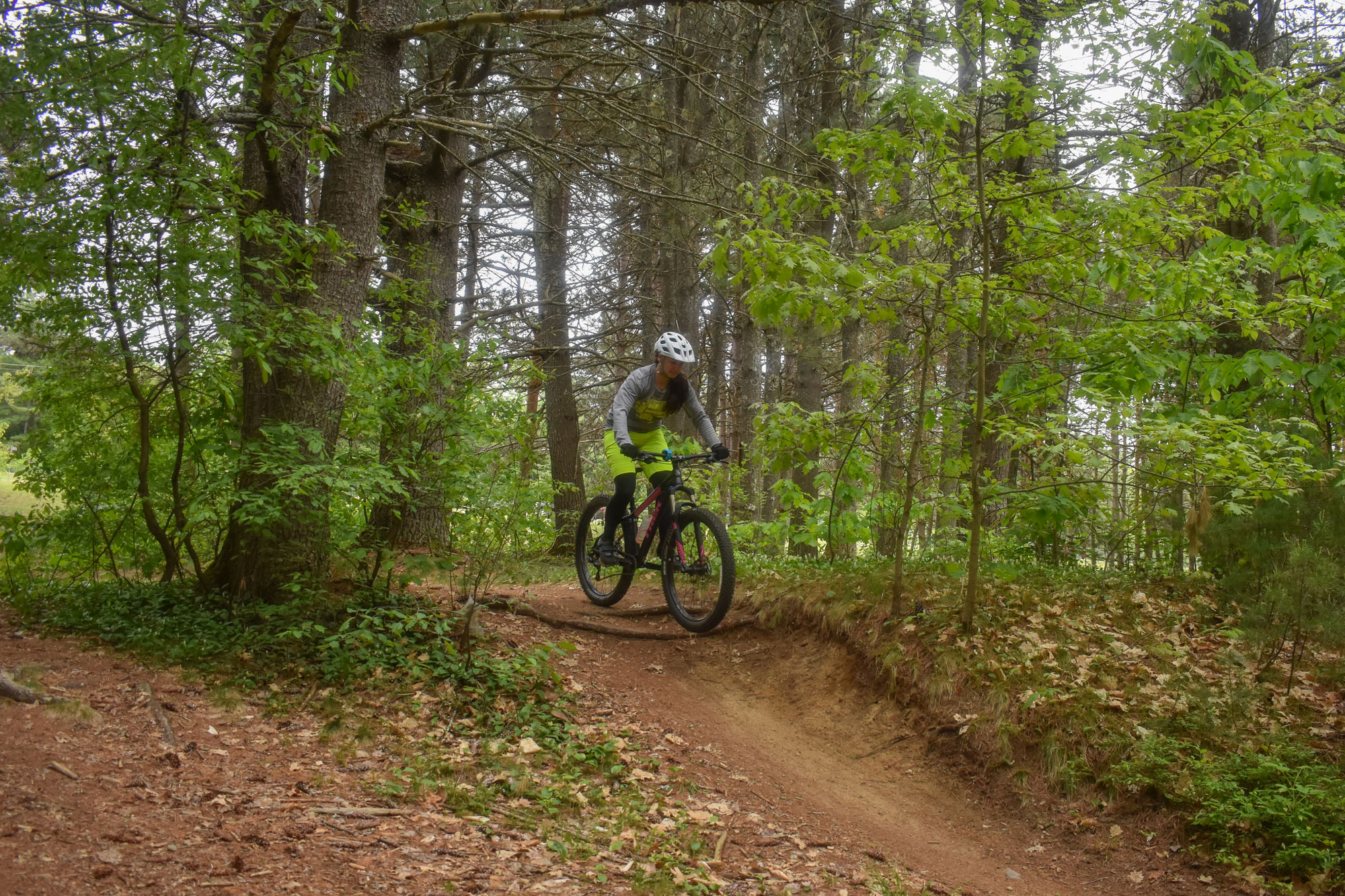After a long winter stuck on the trainer or shivering on the fat bike, it’s no surprise that mountain bikers are ready to shred some “brown pow.” Yet with the arrival of longer days and warm temperatures, riders must temper early-season enthusiasm until trail conditions allow. Riding on muddy trails in the spring is one of the biggest faux pas made by mountain bikers—it can cause long-term damage to the trails themselves and to relationships with landowners and managers, along with creating a ton of work for trail crews.
Not all trails are ready at the same time and conditions vary from season to season, but some are traditionally rideable before others. Below are a few good early-season options for mountain bikers in and around Southern/Central New Hampshire.

FOMBA
The Friends of Massabesic Bicycling Association maintains a network of trails that offers stellar early season riding in the Lake Massabesic watershed. The trails, known simply as FOMBA, are located in Auburn, which is just a short drive from Manchester.
FOMBA features sections of rooty, rocky, and snake-like singletrack connected by fire roads. This makes FOMBA perfect for dialing in riding skills after a long winter, as the fire roads offer a reprieve from the technical trails. Intermediate mountain bikers will find the terrain challenging but not demanding.
The FOMBA trails are designed by mountain bikers with mountain bikes in mind; however, the trails offer a stark contrast to modern machine-made trail systems like Green Woodlands. FOMBA’s trails are tight, twisty, and loaded with natural obstacles. Noticeably absent are any sustained climbs or descents, something early-season legs are sure to appreciate.
FOMBA closes its trails during mud season, eliminating any guesswork of whether you should or shouldn’t ride. A sign noting the mud season closure is generally placed at the entrance of the trails. In addition, information about trail status is also commonly found on the Southern NH NEMBA and FOMBA Facebook pages.

Franklin Falls
Don’t let Franklin Falls’ northernish location fool you—it’s a great early-season place to pedal your mountain bike. The Franklin Falls trail system neighbors Tilton and other Lakes Region communities, and is easily accessible from Interstate 93. Although Franklin Falls receives more snow than its southerly neighbors in most years, its sandy soil and well-packed trails are notoriously quick to dry and the area has a well-deserved reputation for being open when other systems are closed during mud season.
Franklin Falls is another trail system designed by and for mountain bikers. But unlike FOMBA, its trails are more modern and deliver the three Fs: fast, flowy, and fun. Consequently, they’re perfect for building fitness, confidence, and stoke after a winter off the bike.
The trails are generally located on a hillside, and while mountain bikers will find some short, steep climbs and descents, there’s nothing super-long, a boon for those not yet in peak bike shape. It also means that you’ll often find the upper-most trails in mid-season condition while the lower trails are still a little mushy. If so, try to contain your enthusiasm and stick to the top.
Franklin Falls is open all year, but the Central NH NEMBA Facebook page is a good resource for finding current trail conditions. While in Franklin, check out New England’s first white water park—it’s just a few miles away and, when complete, will offer a nice alternative to biking during super-wet springs.

Harold Parker
New Hampshire mountain bikers, especially those close to the Massachusetts border, have another gem just across state lines—Harold Parker State Forest in Andover, MA. It is an awesome early-season riding destination.
While dry trails are often found at Harold Parker, something that is harder to locate is easy trails. Harold Parker is well-known for its techy riding and will provide a test to even the most experienced bikers. Some will enjoy the challenge of tackling the park’s rugged rock gardens and mettle-testing rollers while others will find an intense first time on the bike. Newer riders will likely want to steer clear (or stick to the park’s fire roads).
For many, riding Harold Parker can seem more like mountain hiking than mountain biking; at times, it can feel like you’ve pushed your bike as much as ridden it, especially if your confidence gets shaken early in a ride. That said, after finding your early season legs at Harold Parker, everything else will feel easy.
Harold Parker won’t just test your early season skills, it will also see how your navigational skills stack up. The park’s trails twist and turn on themselves which can make knowing where you are a little confusing. Consider bringing a phone with an app like Trailforks to keep from getting lost.
Everyone is anxious to get back on their bikes in spring, but remember that our actions have consequences that can last for years. If the trails seem squishy, stay off them. Either find a drier place to ride, break out the road bike, or pick another activity. Riding on wet trails damages them, creates extra work, threatens access, and makes you look bad within the mountain bike community.
Do you have a favorite place to ride your mountain bike in the spring? Let us know about it in the comments below!
Tim Peck and Doug Martland
Tim and Doug met long ago at the Eastern Mountain Sports in Canton, Massachusetts. Bonding over a love of slick Quincy Quarry granite, White Mountain sufferfests, and scheming up adventures while folding tee-shirts, today Tim and Doug collaborate to write about their favorite outdoor activities and occasionally get nostalgic about tee-shirt tables.
Related Posts
April 12, 2024
Explore Like a Local: The Outdoor Mecca of North Conway, NH
There's a lot to love about this New…
April 3, 2024
5 Things To Do in the Boston Area During Mud Season
Adventure opportunities are abundant…




